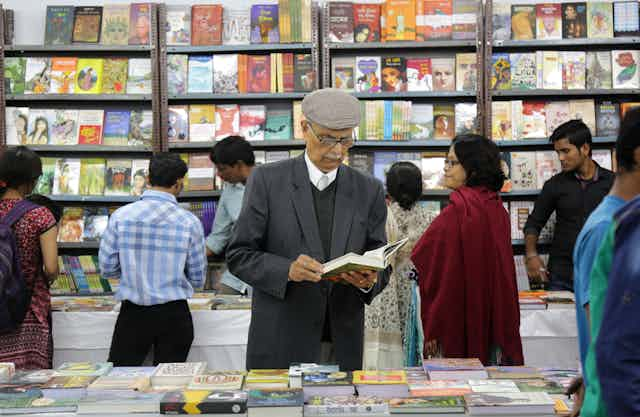English is widely acknowledged as the world’s most successful language. It has developed over the 20th century into a global lingua franca, the most widely used language on the internet, and the clear leader in education and research. But new competitors are emerging to displace English, especially in rich multilingual contexts such as India.
The language Hinglish involves a hybrid mixing of Hindi and English within conversations, individual sentences and even words. An example: “She was bhunno-ing the masala-s_ jub_ phone ki ghuntee bugee.” Translation: “She was frying the spices when the phone rang”. It is gaining popularity as a way of speaking that demonstrates you are modern, yet locally grounded.
New research by my colleagues and I has found that while the hybrid language is not likely to replace English or Hindi in India, more people are fluent in Hinglish than they are in English.
India has the second largest English-speaking population in the world (at 125m), while many speak multiple languages. English fluency is socially prestigious and important for job success and upward mobility.
But, acquiring fluent English (or any language) requires rich and consistent language exposure. In India, this is largely limited to the urban upper classes. Together, these two factors – limited English access and the desirability of becoming an English speaker – could mean that communication styles which are more available to the masses, such as Hinglish, grow faster than English.
Shifts in use
As Hinglish is not yet an official language on census reports, we need to find other ways to assess the language shift. A new avenue is the statistical modelling of language competition. This helps us to explore and predict communnity-wide changes based on local cultural and social factors – for example, the number of languages taught in schools, what languages are useful in the job market and where specific languages are used.
This approach has been successful in modelling language shift in earlier bilingual settings such as Scotland and Wales – which shifted entirely towards English, over Gaelic and Welsh – and for multilingual settings such as Singapore where Mandarin is out-competing both English and Malay.
Our new study uses this language competition approach to explore the social causes and effects of Hinglish growth. While social class is linked to the access to English in India, the kind of predictive model we used also needs data on why and under what contexts language shift is likely. We also wanted to know whether these Hinglish speakers are actually not fluent in any one language, or simply claim this because Hinglish has more social value than Hindi.
We interviewed 24 people who claim Hindi/English bilingualism in the census. After asking them to only use Hindi, we discussed casual topics such as their childhood, their favourite sports and hobbies. No one successfully used monolingual Hindi – instead overall 18.5% of their speech was in English. We also analysed the language used in two full seasons of an Indian reality TV show, looking at how much English was used per speaker in each episode.
Our data revealed two important patterns. First, Hinglish speakers cannot speak monolingual Hindi in settings which require only Hindi (like our interview scenario) – this confirms reports from some speakers that their only fluency is in this hybrid Hinglish. What this means is that, for some speakers, using Hinglish is not a choice – they cannot speak monolingual Hindi, nor monolingual English. Because these Hinglish speakers are not fluent in Hindi, they are not likely to undergo language shift to monolingual Hindi.
Second, bilinguals adjust their speech towards Hinglish when they talk to Hinglish speakers. Over time, the number of Hinglish speakers is growing by adopting speakers from the bilingual community who lose the need to use either language monolingually.
Predator and prey
Our study argued that the interactions resemble those between a predator and its prey. Acting as prey, Hindi monolinguals can become Hindi/English bilinguals. At the same time, the Hinglish-speaking population acts as the top predator, so that both bilinguals and monolinguals can become Hinglish speakers over time.
Conflicts between the the desire for English fluency and the reality of limited English access and job opportunities make sense. While a small number of monolingual Hindi speakers may become fluent in English (shifting to the bilingual community), limited access to rich and consistent English language exposure will constrain this. Most will only learn some English, and move into the Hinglish community when they intermix this with their Hindi.
In the English job market, bilinguals who lose their jobs (and their need for fluent English), are likely to shift to Hinglish because of the local value associated with using the hybrid; but they are not likely to entirely lose English to become Hindi monolinguals – again because of the higher prestige of Hinglish.
Over time, our model suggests that all three speech communities will survive, and Hinglish is not likely to replace English or Hindi, as some reports have suggested.
Yet broadly, our research suggests that the English/Hindi bilingual population has been overestimated in Indian census reports – Hinglish is actually overtaking full English fluency in India. The Hinglish population has evolved to fill a niche between monolingual Hindi and full bilingualism because Hinglish responds to the need for a modern, yet localised way speaking which is also available to the masses.

